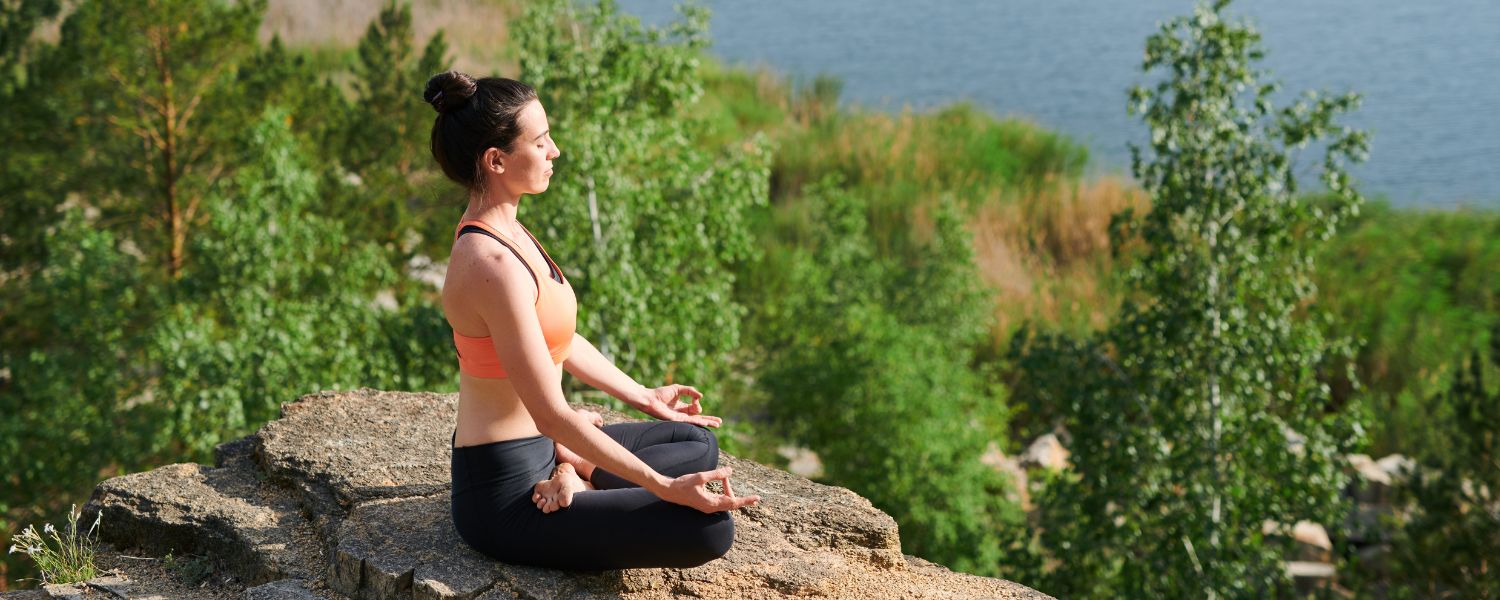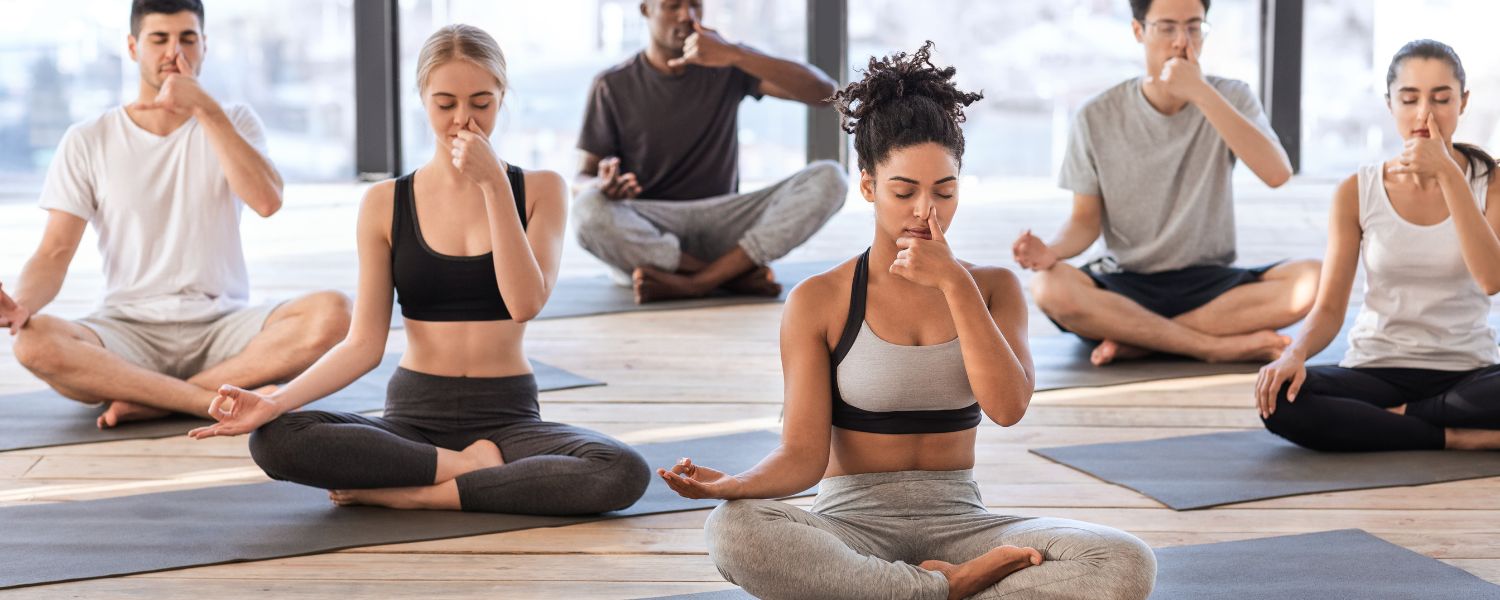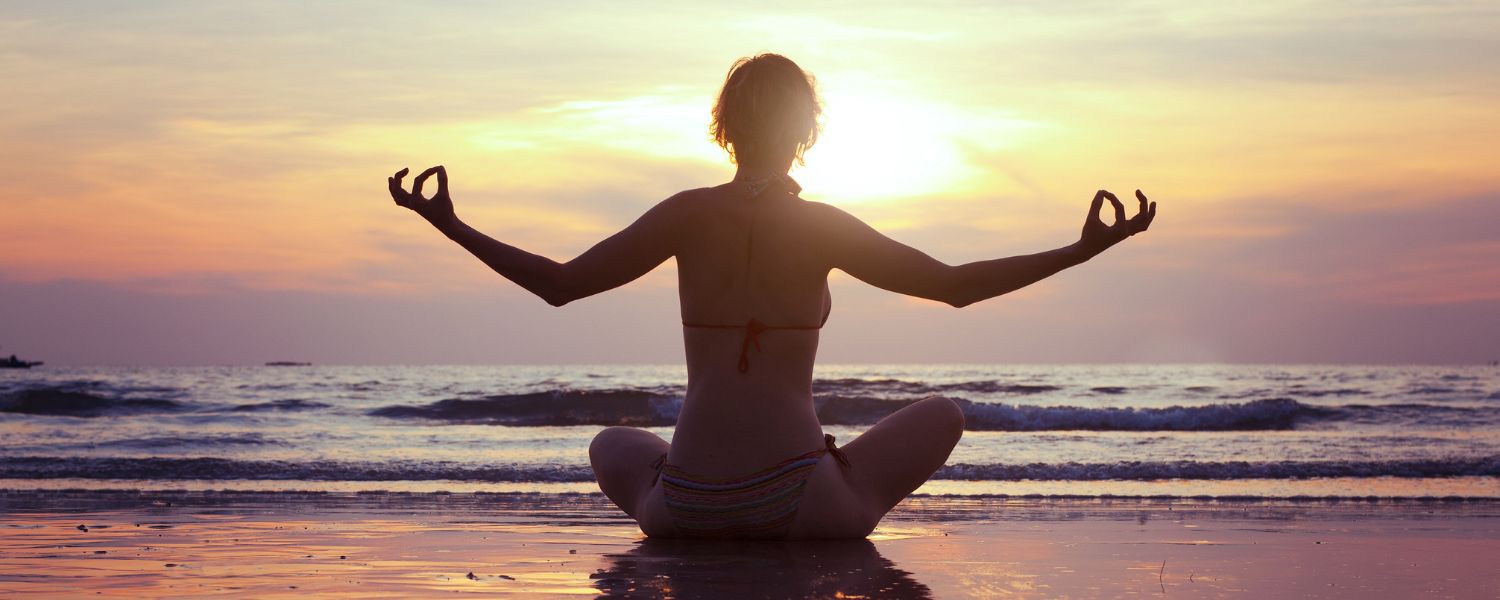Starting your day with morning yoga breathing exercises can set a positive tone for the rest of your day, infusing you with energy and vitality.
In yoga, breathing exercises, also known as pranayama, are vital in enhancing physical, mental, and emotional well-being.
By incorporating specific breathing techniques into your morning routine, you can optimize your energy levels, boost your focus and clear thinking, and help you feel more peaceful inside so you can handle whatever comes your way.
Importance of Breathing in Yoga

In yoga philosophy, the breath is considered the bridge between the body and the mind.
Conscious breathing regulates the flow of prana, or life force energy, throughout the body, promoting balance and harmony.
Through pranayama practices, yogis harness the power of the breath to quiet the mind, release tension, and connect with the present moment.
By focusing on the breath, practitioners can deepen their yoga practice and experience a heightened sense of awareness and mindfulness.
Setting the Stage for Your Practice

Setting the stage for your morning yoga breathing practice involves creating a conducive environment that supports relaxation, focus, and mindfulness.
Start by discovering a peaceful spot where you can do your exercises without any interruptions.
This could be a corner of your living room, a dedicated yoga space, or even a spot outdoors if weather permits.
Clear away any clutter and create a sense of openness and calm.
Next, consider setting the mood with lighting.
Natural light can be invigorating, so if possible, practice near a window where you can enjoy the morning sunlight.
Alternatively, you can dim the lights or use candles or soft lighting to create a more soothing atmosphere.
To enhance the sensory experience, you may choose to incorporate aromatherapy.
Burning incense, diffusing essential oils, or lighting a scented candle creates a sense of tranquility and focus.
Before you begin your breathing exercises, take a few moments to center yourself.
Close your eyes, take a few deep breaths, and think about what you want to focus on during your practice.
It could be something like feeling grateful or getting in the right mindset for the day ahead.
By taking the time to set the stage for your practice, you create a supportive environment that allows you to fully immerse yourself in your breathing exercises and reap the maximum benefits of your practice.
Warm-Up and Preparation

Warm-Up and Preparation are crucial steps in any yoga practice, including morning breathing exercises.
This phase is about gently awakening the body and mind, preparing them for deeper engagement and relaxation.
First, locate a peaceful and cozy spot where you can concentrate without interruptions.
Set aside a dedicated time for your practice, ensuring you won't be rushed.
Creating this environment helps signal your mind that it's time to transition into mindfulness and presence.
Once settled, begin with gentle movements to awaken the body.
Cat-cow stretches, where you arch and round your back in sync with your breath, loosen up your spine and relieve tension in your back and neck.
Spinal twists gently massage the internal organs, promoting digestion and detoxification.
Forward folds lengthen the hamstrings and release tension in the lower back and hips.
Pay attention to your body's signals as you move through these warm-up exercises.
Notice areas of tightness or discomfort, and move mindfully to gently open and release them.
This phase isn't about pushing yourself to the limit but rather about tuning into your body's needs and respecting its boundaries.
By taking the time to warm up properly, you're preparing your body to receive the full benefits of your breathing practice.
You're also signaling to your mind that it's time to shift gears, setting the stage for a deeper, more focused practice ahead.
Warm-Up and Preparation are essential components of your morning routine, ensuring you start your day feeling grounded, centered, and ready to embrace whatever lies ahead.
Morning Yoga Breathing Exercises

Now that you're warmed up and ready to go, let's explore some invigorating breathing exercises to wake up your body and mind:
1. 4-7-8 Breathing Method
This technique is like a calming breath hug for your nervous system.
When you inhale for 4 seconds, hold for 7, and exhale for 8, you're sending a signal to your body that it's time to relax.
The extended exhale triggers a response that slows your heart rate and calms your mind, perfect for starting your day with a clear head.
It's also handy for managing any stress or anxiety that might creep in as you wake up and prepare for the day ahead.
With practice, you'll find that this breathing pattern becomes a reliable friend in moments of tension, helping you navigate challenges with a sense of calm and control.
2. Alternate Nostril Breathing
This one might seem a bit quirky, but it's rooted in ancient yogic wisdom and packs a powerful punch for balancing your energy.
By alternating the flow of breath between your nostrils, you're essentially harmonizing your brain's left and right hemispheres.
This improves focus and concentration, which makes it an excellent practice to kickstart your day with clarity and intention.
It's also a fantastic tool for calming the mind and reducing stress, as it encourages a slower, more rhythmic breath pattern.
Plus, the act of physically closing off one nostril at a time can be a grounding sensation, anchoring you in the present moment and preparing you for whatever lies ahead.
3. Breath of Fire
Don't let the name intimidate you—this breathwork technique is all about igniting your inner fire and boosting your energy levels.
By rapidly pumping the breath in and out through your nose, you're increasing oxygen flow to your brain and body, waking up your cells and invigorating your entire being.
It's like a shot of espresso for your respiratory system, minus the caffeine crash.
This practice is particularly beneficial for shaking off any morning grogginess and getting your blood flowing.
It's also a great way to stoke your inner motivation and enthusiasm for the day ahead, helping you step into each moment with vitality and purpose.
Plus, the rhythmic belly movements accompanying Breath of Fire can be a fun way to connect with your body and cultivate a sense of joy and aliveness first thing in the morning.
Benefits of Each Breathing Exercise

Each morning yoga breathing exercise offers its unique benefits:
1. 4-7-8 Breathing Method
This technique promotes relaxation by engaging the parasympathetic nervous system, inducing a calming effect.
By inhaling for a count of four, holding for seven, and exhaling for eight, you stimulate the body's relaxation response, reducing stress and anxiety levels.
This method can be particularly helpful in managing anxiety and promoting better sleep, allowing you to start your day feeling refreshed and rejuvenated.
2. Alternate Nostril Breathing (Nadi Shodhana)
Nadi Shodhana helps balance the body's energy flow, promoting a sense of equilibrium and harmony.
By alternating between the left and right nostrils, you activate the ida and pingala nadis, the energy channels associated with the parasympathetic and sympathetic nervous systems.
This practice calms the mind, enhances focus, and regulates the breath, leaving you feeling centered and grounded as you begin your day.
3. Breath of Fire (Kapalabhati)
Kapalabhati increases oxygenation and circulation, invigorating the body and mind.
This rapid, rhythmic breathing technique stimulates the solar plexus, generating heat and energy in the body.
You massage the internal organs by engaging the abdominal muscles, promoting detoxification and improving digestion.
Breath of Fire awakens the senses, clears mental fog, and boosts vitality, preparing you to tackle the day ahead with renewed energy and clarity.
Practice Tips

As you explore these morning yoga breathing exercises, keep the following tips in mind to enhance your practice:
1. Start Slowly
It's essential to ease into your morning breathing routine, allowing your body to adjust gradually.
Begin with a comfortable pace, focusing on establishing a steady rhythm.
As you get more comfortable with the exercises, feel free to slowly make them a bit more challenging by increasing how long you do them and how intense they are.
This approach prevent strain or discomfort and allows you to build confidence in your practice over time.
2. Listen to Your Body
Your body communicates its needs and limits, so pay attention to any signals it sends during your breathing exercises.
If you start to feel dizzy, short of breath, or uncomfortable, it's essential to listen and take a break.
Pushing through discomfort leads to strain or injury, so honor your body's cues. Take a break and return to normal breathing until you feel ready to resume.
Your practice should challenge you, but never at the expense of your well-being.
3. Consistency is Key
Like any skill or practice, consistency is very important for reaping the benefits of morning breathing exercises.
Aim to incorporate these techniques into your daily routine, even if only for a few minutes each morning.
Consistency allows your body and mind to adapt and respond to the practice, gradually enhancing your overall well-being and vitality over time.
4. Be Patient
Learning new breathing techniques takes time and patience.
Don't expect to master them immediately—be gentle with yourself as you explore and experiment with different methods.
It's natural to encounter challenges or moments of frustration along the way.
See these challenges as chances to improve and gain knowledge, trusting that you'll gradually become more comfortable and proficient in your breathing practice with perseverance and practice.
5. Stay Present
The essence of mindfulness is being fully present in the moment, which also applies to your morning breathing practice.
Focus your attention on the sensations of your breath as it moves in and out of your body.
By staying present and attentive during your practice, you deepen your connection with yourself and cultivate a greater sense of calm and clarity that can positively influence your entire day.
6. Combine with Yoga Asanas
Integrating breathing exercises with yoga poses (asanas) can enhance the benefits of both practices.
Asanas help open the body, release tension, and increase flexibility, while conscious breathing amplifies the mind-body connection and promotes relaxation.
Experiment pairing different breathing techniques with specific yoga poses to create a personalized practice that addresses your unique needs and goals.
7. Seek Guidance if Needed
If you have any concerns about your breathing practice or how it may affect your health, don't hesitate to take advice from a qualified yoga instructor or healthcare professional.
They can offer personalized advice, modifications, or additional resources to support your practice safely and effectively.
Remember that your well-being is paramount, so trust your instincts and reach out for assistance if you need it.
Conclusion
Morning yoga breathing exercises offer a powerful way to energize your day and cultivate a sense of well-being from the inside out.
When you weave certain breathing exercises into your morning habits, you unlock the incredible potential of your breath to boost your overall well-being—both physically and mentally.
Whether you start your day with the calming 4-7-8 breathing method, the balancing practice of alternate nostril breathing, or the refreshing breath of fire, you'll set yourself up for a day filled with vitality, clarity, and inner peace.
Commit to making these morning yoga breathing exercises a regular part of your routine, and watch as they help you greet each day with renewed energy and enthusiasm.
Green Apple Activewear enhances your morning yoga breathing exercises by providing comfortable, breathable attire that supports your movements.
With their flexible fabrics and ergonomic designs, Green Apple Activewear allows for unrestricted mobility, enabling you to flow seamlessly through your breathing routines.
The moisture-wicking properties of their clothing keep you dry and comfortable, enhancing your focus and concentration during practice.
Additionally, Green Apple's eco-friendly materials align with the mindful ethos of yoga, promoting harmony with both your body and the environment.
So, slip into your Green Apple Activewear and elevate your morning yoga experience to new heights of comfort and sustainability.
Start your morning yoga routine with Green Apple Activewear for enhanced comfort and support.
Lay out your Yoga Mat and secure it with the Shoulder Strap for stability during poses. Slip into the New Mya Legging - Black Dove for flexibility and freedom of movement.
With its moisture-wicking fabric, it keeps you dry and focused.
Pair it with the Estelle Fitted Flare - Black Beauty for a stylish touch.
These activewear pieces not only provide the right fit but also allow you to breathe deeply and fully, enhancing your Morning Yoga Breathing Exercises for a revitalizing start to your day.










